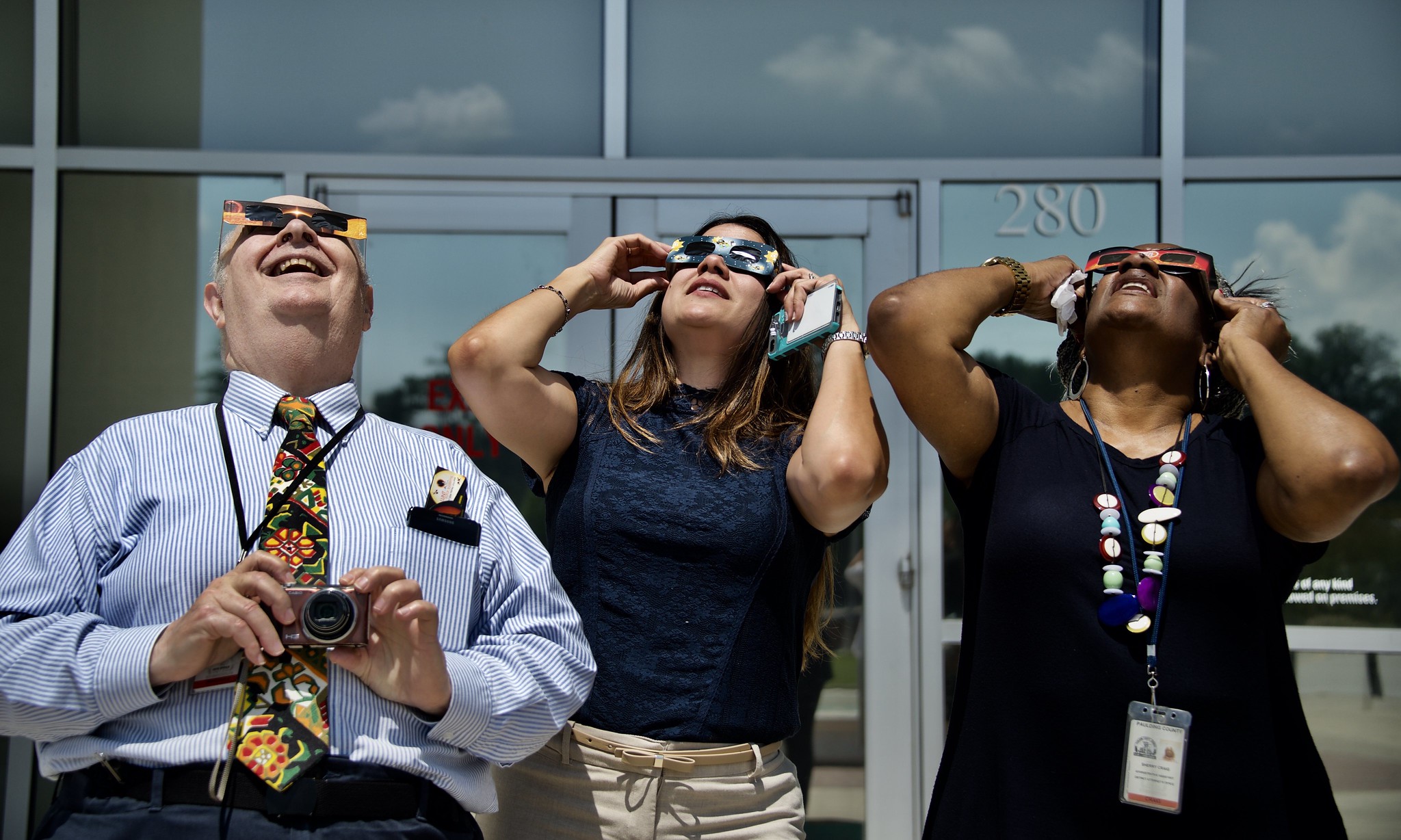It is never safe to look directly at the sun’s rays – even if the sun is partly obscured. When watching a partial eclipse you must wear eclipse glasses at all times if you want to face the sun or use an alternate indirect method such as pinhole projection, or a telescope with a solar filter. This also applies during a total eclipse up until the time when the sun is completely and totally blocked. If you attempt to view an eclipse incorrectly you can cause permanent eye damage or even blindness.
During the short time when the moon completely obscures the sun – known as the period of totality – it is safe to look directly at the star, but it’s crucial that you know when to take off and put back on your glasses.

Eclipse Glasses
When it comes to solar-eclipse glasses and other solar viewers, it’s important to ensure that the product you’re using is safe and effective at blocking harmful radiation from the sun. Just because something looks like suitable eye protection doesn’t mean it’s safe to use. Even if a product is advertised as a solar viewer, it’s important to look for a label that says ISO 12312-2 (sometimes written as ISO 12312-2:2015), which stands for the International Organization for Standardization. Filters that are ISO 12312-2 compliant not only reduce visible sunlight to safe and comfortable levels but also block solar UV and IR radiation.
The ISO is an independent organization that writes safety and quality standards for all kinds of things, including eyewear, health care, food production, and more based on a broad consensus of the scientific community. If you find eclipse glasses or other solar viewers that aren’t labeled ISO, then they aren’t guaranteed to protect your eyes the way they should.
ISO-approved solar-eclipse glasses must meet certain safety requirements:
- No more than 0.00032 percent of the sun’s light may be transmitted through the filters.
- The filters must be free of any defects, such as scratches, bubbles, and dents.
- Handheld viewers must be large enough to cover both eyes.
- Labels on the viewers (or packaging) must include the name of the manufacturer, instructions for safe use, and warnings of the dangers of improper use.
Be very careful and don’t use any product unless claims of safety can be verified. For the 2017 eclipse, there were many reports of unsafe eclipse glasses that were manufactured in China and being distributed on Amazon as well as reports of counterfeit eclipse glasses printed with names of reputable manufacturers. Don’t risk cooking your retinas with fake eclipse glasses — get your safe, ISO-certified glasses here.
What to Avoid
Ordinary sunglasses (or multiple pairs of sunglasses), neutral density or polarizing filters (such as those made for camera lenses), smoked glass, photographic or X-ray film (unexposed, exposed, or developed), “space blankets,” potato-chip bags, DVDs, and any other materials you may have heard about for solar viewing are not safe. In some cases, these homemade filters may seem like they dim the Sun to a comfortable level, but that doesn’t mean they do so across the whole electromagnetic spectrum. While you’re enjoying a “comfortable” view of the “dim” Sun, solar infrared radiation could be cooking your retinas. And you wouldn’t know till later, because your retinas don’t have pain receptors. Only after the eclipse, when you notice blind spots or other vision problems, would you realize you’d made a catastrophic mistake.
What about welding filters? The only ones that are safe for direct viewing of the Sun with your eyes are those of Shade 12 or higher. These are much darker than the filters used for most kinds of welding. If you have an old welder’s helmet around the house and are thinking of using it to view the Sun, make sure you know the filter’s shade number. If it’s less than 12 (and it probably is), don’t even think about using it to look at the Sun. Many people find the Sun too bright even in a Shade 12 filter, and some find the Sun too dim in a Shade 14 filter — but Shade 13 filters are uncommon and can be hard to find. In any case, welding filters generally give a sickly green image of the Sun, whereas special-purpose solar viewers give a white, yellow, or orange image, which is much more pleasing and natural.

Don’t Risk Harming Your Vision!
Purchase your very own USA Made, ISO 12312-2:2015
certified Eclipse Glasses today!
